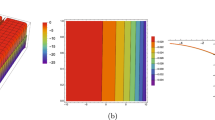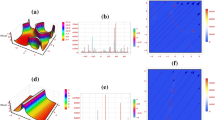Abstract
—Water waves generated by submarine landslides may constitute a serious hazard for coastal population and environment. These masses may be giant, as documented by several examples in recent history and by numerous geological traces of paleo-events. A theoretical investigation on wave generation and wave energy is performed here by using a model that is based on some simplifying assumptions. The landslide is treated as a rigid body moving underwater according to a prescribed velocity function. Water waves are governed by the shallow-water wave equations, where water velocity is constant through the water layer and vertical velocity is negligibly small. Geometrically simple basins are considered with either constant depth or constant slope, since attention is focused on the fundamental characteristics of the generation process. Analytical 1-D solutions as well as 1-D and 2-D numerical results obtained by means of a finite-element model are used to gain understanding of the energy transfer from a moving body to the water. From the 1-D examples, it is found that if slide duration is sufficiently long, water usually gains energy in the form of waves until a saturation point is reached, when body motion is no longer capable of producing a net transfer of energy from the rigid body to water. Finite-duration motions of a body moving at constant speed along a flat ocean floor can be used as canonical examples, since bottom slopes cannot significantly change the generated wave pattern. Typically, two trough-crest systems are developed that travel in opposite directions, with the leading crest in the direction of the slide and the leading trough toward the other direction. The amplitude of the former is generally higher, with amplitude controlled by the Froude number (ratio of body velocity to long waves phase celerity) and wavelength dictated by landslide length. Generation and propagation of 2-D cases show a more complicated pattern, since lateral radiation plays an important role. Some of the features present in the 1-D models are observed in 2-D wavefields, however substantial differences arise. The most significant difference is that no energy saturation takes place in 2-D, since the body transfers energy to the water as long as it moves.
Similar content being viewed by others
Author information
Authors and Affiliations
Additional information
Received November 30, 1998, accepted June, 7 1999
Rights and permissions
About this article
Cite this article
Tinti, S., Bortolucci, E. Energy of Water Waves Induced by Submarine Landslides. Pure appl. geophys. 157, 281–318 (2000). https://doi.org/10.1007/s000240050001
Issue Date:
DOI: https://doi.org/10.1007/s000240050001




